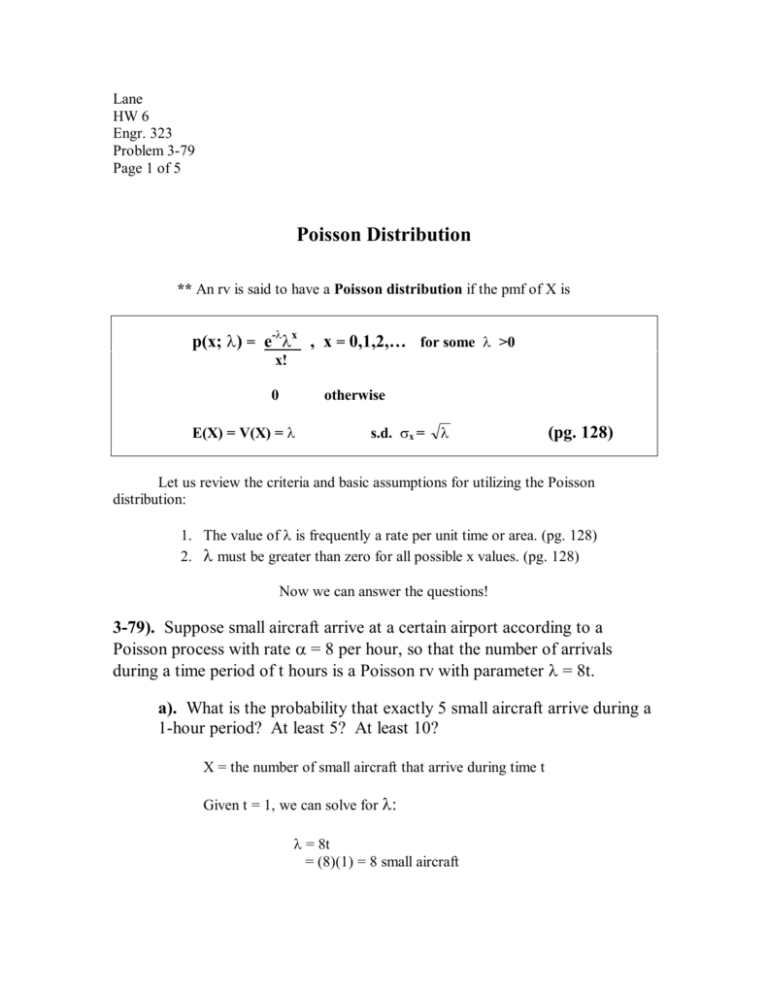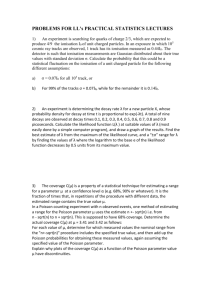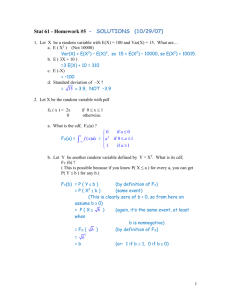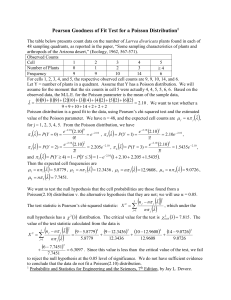Poisson Distribution
advertisement

Lane HW 6 Engr. 323 Problem 3-79 Page 1 of 5 Poisson Distribution ** An rv is said to have a Poisson distribution if the pmf of X is p(x; λ) = e-λλx , x = 0,1,2,… for some λ >0 x! 0 otherwise E(X) = V(X) = λ s.d. σx = λ (pg. 128) Let us review the criteria and basic assumptions for utilizing the Poisson distribution: 1. The value of λis frequently a rate per unit time or area. (pg. 128) 2. λmust be greater than zero for all possible x values. (pg. 128) Now we can answer the questions! 3-79). Suppose small aircraft arrive at a certain airport according to a Poisson process with rate α = 8 per hour, so that the number of arrivals during a time period of t hours is a Poisson rv with parameter λ= 8t. a). What is the probability that exactly 5 small aircraft arrive during a 1-hour period? At least 5? At least 10? X = the number of small aircraft that arrive during time t Given t = 1, we can solve for λ: λ= 8t = (8)(1) = 8 small aircraft Lane HW 6 Engr. 323 Problem 3-79 Page 2 of 5 To find the probability of exactly 5 small aircraft arriving given that λ= 8 we can use the definition of a Poisson distribution. -8 5 P(X = 5) = e (8) = 0.091 5! 4 P (X ≥ 5) = 1 – P(X ≤4) = 1 - ∑ e-88x x=0 x = 1-F(5) **F(5) can be found on Figure 2 (Poisson CDF). = 1 - e-8(80/0! + 81/1! + 82/2! + 83/3! + 84/4! 85/5!) = 1 – 0.1 = 0.900 **There is a very useful tool in our book to make these large summations really fast and painless! In the appendix tables there are several cumulative properties. On page 703, Table A.2 displays the cumulative Poisson probabilities. To use this table we need to know λand x. Let’s use the table to solve this next probability. 9 P(X ≥ 10) = 1 – P(X ≤9) = ∑ e-88x = 1-F(9) **(Figure 2). x=0 x In this case, λ= 8 and x = 9. We read 9 down and 8 across to find 0.717 = 1- 0.717 = 0.283 0.15 0.1 0.05 0 0 1 2 3 4 5 x 6 7 Figure 1- Poisson PMF with λ= 8 8 9 10 Lane HW 6 Engr. 323 Problem 3-79 Page 3 of 5 0 0 0 0 0 0 0 0 0 .9 .8 .7 .6 .5 .4 .3 .2 .1 0 0 1 2 3 4 5 x 6 7 8 9 Figure 2- Poisson CDF with λ= 8 b). What are the expected value and standard deviation of the number of small aircraft that arrive during a 90-minute period? ** When using Poisson distribution, E(X) = V(X) = λ σ= λ (pg. 130) We are given that t = 1.5 hours so now we can solve for λ. λ= 8t = E(X) λ= (8)(1.5) = 12 arrivals are expected over 1.5 hrs. The standard deviation (σ) is the square root of the expected value Thus, σ = λ σ = 12 = 3.464 arrivals over 1.5 hours. 10 Lane HW 6 Engr. 323 Problem 3-79 Page 4 of 5 c). What is the probability that at least 20 small aircraft arrive during a 2-½ hour period? That at most 10 arrive during this period? Given that t = 2.5 we can solve for λ. λ= 8t λ= (8)(2.5) = 20 Now that we know λwe can solve the probabilities. ∞ P (X ≥ 20) = ∑ e-λλx X=20 x! **Although it would be possible to solve the problem this way, there is a much easier way to approach it. 19 P (X ≥ 20) = 1 – P (X ≤19) = 1 – ∑ e-λλx = 1-F(19) x=0 x! -20 0 1 2 = 1 - e (20 /0!+20 /1!+20 /2!+… +2019/19! ) = 1 – 0.470 (from table) = 0.53 10 P (X ≤10) = ∑ e-2020x = 0.011 (from table) x=0 x! 0.008 0.006 0.004 0.002 0 0 1 2 3 4 5 x 6 7 Figure 3- Poisson PMF for λ= 20 8 9 10 Lane HW 6 Engr. 323 Problem 3-79 Page 5 of 5 F(x) C D F fo r 3 - 7 9 P a rt c 0.015 0.01 0.005 0 0 2 4 6 x Figure 4- Poisson CDF for λ= 20 8 10 Lane HW 6 Engr. 323 Problem 3-79 Page 1 of 2 3-85). Suppose that trees are distributed in a forest according to a twodimensional Poisson process with parameter α, the expected number of trees per acre, equal to 80. a). What is the probability that in a certain quarter-acre plot, there will be at most 16 trees? T(a) = No. of trees in an acre Since the expected number per acre is 80 trees, the expected number per quarteracre is 20 trees. P(a)~Poisson(x = αa) The parameter = α = (80 trees per acre) (1/4 acre) = 20 trees Now that we know the parameter, we can solve for the P(X ≤16). 16 P(T(a=0.25) ≤16) = ∑ e-2020x = F(16) = 0.221 (from table) x=0 x! b). If the forest covers 85,000 acres, what is the expected number of trees in the forest? If one acre has an expected value of 80 trees, then the entire forest of 85,000 acres has an expected value of 6,800,000 trees. E(entire forest)= E(T(a=85,000)) = (α)(total acreage) = (80)(85,000) =6,800,000 trees Lane HW 6 Engr. 323 Problem 3-79 Page 2 of 2 c). Suppose you select a point in the forest and construct a circle of radius 0.1 mile. Let X = the number of trees within that circular region. What is the pmf of X? (hint: 1 square mile = 640 acres.) To solve this problem we need to pull out a few tricks. First thing to recall is that 2 the area of a circle is πr . 2 Area = πr = (π)(0.1mile)2 = .0314 miles2 The units of miles are not useful to us because all the previous information has been in acres. Now we can use the hint that was given to convert the miles to acres. .0314 miles2 × 640 acres = 20.1 acres 1 mile2 ** So, now we can finally show the pmf of T. T has a Poisson distribution with parameter 20.1 OR p ( T ; 20.1) 0.1 0.09 0.08 0.07 0.06 0.05 0.04 0.03 0.02 0.01 0 0 20 40 60 80 T = Number of Trees per 0.1 Mile Radius Figure 5- Poisson Distribution with parameter 20.1 100










